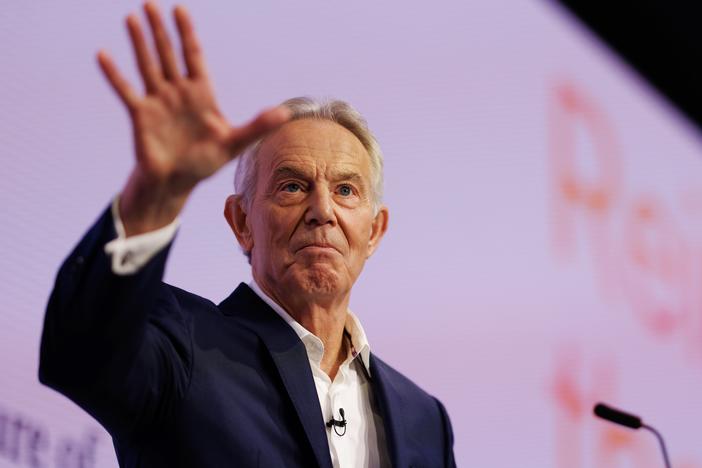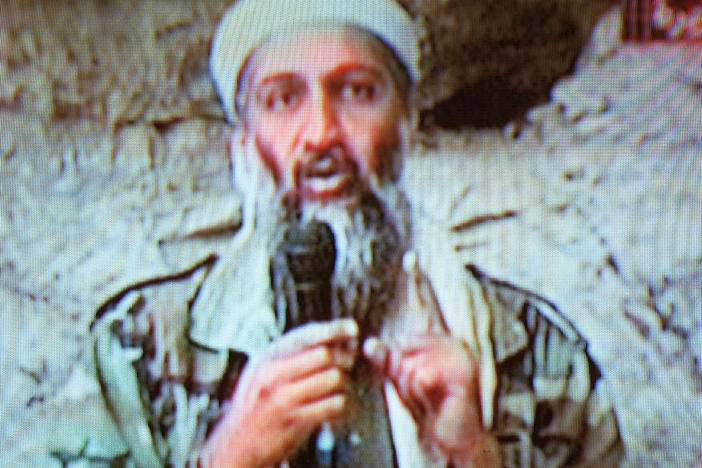Section Branding
Header Content
'Red Line' Examines Syria's Use Of Chemical Weapons, And The World's Discovery Of It
Primary Content
Journalist Joby Warrick takes a detailed look at an excruciating moment for the world — the time in 2013 when the U.S. concluded that Syria's government had used chemical weapons in its civil war.
Transcript
STEVE INSKEEP, HOST:
A new book takes a detailed look at an excruciating moment for Syria, the United States and the world. It's the time in 2013 when the U.S. concluded that Syria's government had used chemical weapons in its long running civil war. President Barack Obama, having warned Syria not to do that, held off on a military strike. The government agreed instead to give up chemical stockpiles, though, the war went on and continues to this day. In his book "Red Line," Joby Warrick reconstructs those moments using interviews, documents, cellphone videos. He describes pivotal moments in the war, including these paragraphs describing a day when Syrians in one town looked up at the sky.
JOBY WARRICK: (Reading) From above the town came the faint whir of a lone helicopter drifting down from the north, unhurried and very high, well beyond the reach of ground fire. From the barricades, it appeared small and almost beautiful, a tiny pearl of reflected sunlight floating above the ruins and squalor of an ordinary Syrian town under siege. Then, as the rebels watched, something fell from the chopper and began hurtling toward the ground in a slow tumble, like a piece of furniture jettisoned at 10,000 feet. Some who saw it raised their cellphones to take video of the falling thing, not yet aware that they were witnessing a portent.
INSKEEP: What was happening in that scene you just described?
WARRICK: This is what happens in this northern city of Saraqib in 2013 when there is a couple of canisters - just like tear gas canisters - that drop from a helicopter into this small town. And one happens to land right in the courtyard of this family that's just minding their own business, trying to survive the siege. And the woman of the house walks outside to her courtyard where this thing has fallen. And this lethal gas - turned out to be sarin - seeps out. And she's immediately stricken and becomes ill. But the amazing thing about her story is the fact that her body ends up being transported into Turkey because her family is trying to get medical attention for her. And because she dies in Turkey, her body is preserved. And so when the United Nations is going around months later trying to investigate these reports of a chemical attack, they have this incredible resource, a body, evidence. So they can conduct an autopsy and try to find out exactly what killed her. And that's what they do.
INSKEEP: Who did the United Nations send into Syria to investigate and learn more?
WARRICK: The person they recruited to head this mission is this retired professor whose name is Ake Sellstrom. He has this extensive background with chemical warfare. He knows the physiology. He knows the weapons themselves. So he is set into Syria for what is really a mission impossible, to try to convince the Syrians to let him conduct a real investigation, to go to places, to talk to victims. And he gets there. And predictably, the Syrians don't want to have anything to do with him. They invite him in. But then they essentially box him in in his hotel. They're refusing to cooperate. They refuse even to admit they have a chemical weapons program. So he's at a dead end. And it looks like this mission is a failure.
INSKEEP: And yet he ended up having a significant effect on world events, really. What was it that he did?
WARRICK: As he is in Syria, almost giving up hope, thinking that his mission is over, he goes to bed in his hotel one night, the night of the 20th - 21st of August, 2013. And while he's asleep, this incredible chemical weapons attack takes place in the suburbs about five miles from his hotel. This is the big one that listeners will remember where more than 1,000 people were killed by sarin. And it happens to take place when this team of investigators are in the country to look at this very problem. And they push right away for the Syrians to let them go and investigate, collect samples and prove to everyone, the world, what really happened there.
INSKEEP: While they were pushing for that evidence, wasn't the United States, under the administration of President Obama, thinking about how to respond to this?
WARRICK: For the United States, for the White House, the Obama administration, there's a different pressure because Obama, as we know, had declared a red line for the chemical use in Syria. They had what they thought was evidence that this is really a chemical weapons attack. But here was this Swedish professor in the way because he was on the ground in Syria. And so Obama began pushing very hard for the U.N. to pull him out.
INSKEEP: This is an incredible thing that you say. You have a quote - and this is a sentiment I had not read or heard anywhere - that people in the administration felt that President Obama was ready to strike Syria that moment. And, in fact, he would have struck Syria that moment, except for this one guy who declined to leave.
WARRICK: The existence of this U.N. team becomes an obsessive matter for the president himself. He raises it with his staff. He goes to the U.N. Secretary General Ban Ki-moon at the time, says, get these guys out at once. There are several things that are weighing on the president's mind at this time. First of all, is this whole kind of specter of weapons of mass destruction and a war in the Middle East. So he wants to make sure that his intelligence is correct. But he is absolutely intent on launching these missiles if he can get this inspector out. But what unfolds over the next few days is Sellstrom remains in Syria. He continues to do his work. He finds his evidence. And as time elapses, the momentum for a strike starts to fade.
INSKEEP: People who were following news then will recall generally what happened. Russia offered to arrange with its ally, Syria, to remove its chemical weapons. The United States ultimately took that deal and did not launch a missile strike. But now a few years have passed. What were the practical effects of the United States backing away from that strike on Syria?
WARRICK: The results are really interesting because in a way, this becomes part of a larger failure in Syria. We don't stop the war. We don't end the suffering. We don't stem the tide of refugees and this massive humanitarian crisis. And yet, at the same time, because of the deal, we do manage to get 1,300 tons of really dangerous stuff out of Syria, which is remarkable in the fact that, first of all, Syria didn't initially acknowledge it had any of it. But because of this deal, they were forced to join the Chemical Weapons Convention, allow inspectors in the country. And they eliminated about 90 to 95% of the entire stockpile, plus their production equipment. And that has never happened in the history of arms control.
In the middle of a civil war, we managed to get a country to unilaterally disarm. It wasn't a complete disarmament. They kept back some of it, as we later discovered. But some terrible things that could have been used to kill lots of Syrians or smuggled out of the country, which is the other scary scenario - lots of folks would have loved to have gotten their hands on even a few liters of sarin to use in a terrorist attack. That stuff is taken out of the country during a war and destroyed at sea.
INSKEEP: Joby Warrick is the author of the new book "Red Line: The Unraveling Of Syria And America's Race To Destroy The Most Dangerous Arsenal In The World." Thanks so much.
WARRICK: Thank you. I really enjoyed it.
(SOUNDBITE OF KENO AND TRISTAN DE LIEGE'S "NKOSI") Transcript provided by NPR, Copyright NPR.
Bottom Content



